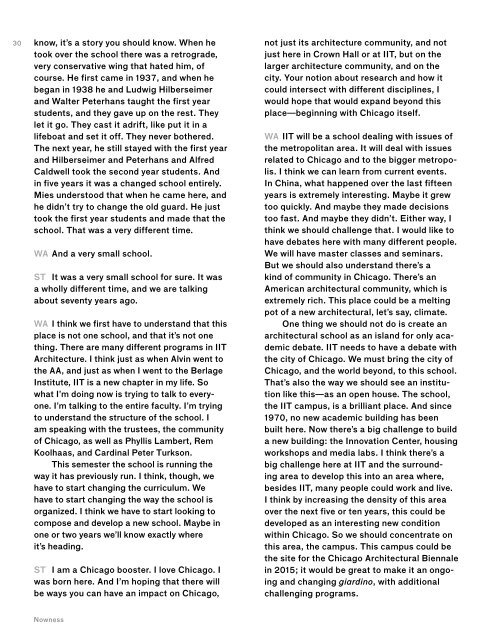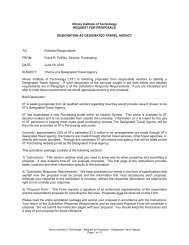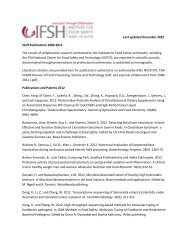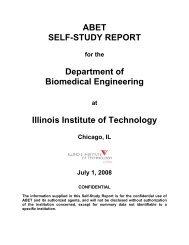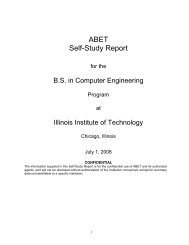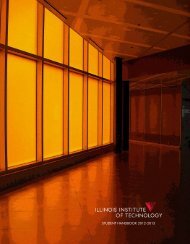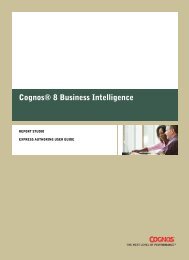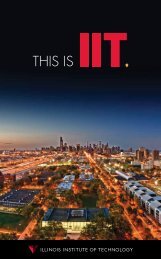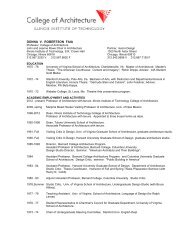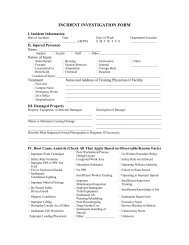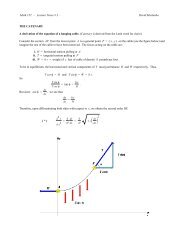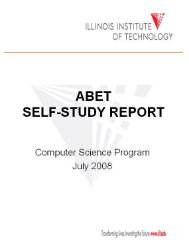Nowness - Illinois Institute of Technology
Nowness - Illinois Institute of Technology
Nowness - Illinois Institute of Technology
Create successful ePaper yourself
Turn your PDF publications into a flip-book with our unique Google optimized e-Paper software.
know, it’s a story you should know. When he<br />
took over the school there was a retrograde,<br />
very conservative wing that hated him, <strong>of</strong><br />
course. He first came in 1937, and when he<br />
began in 1938 he and Ludwig Hilberseimer<br />
and Walter Peterhans taught the first year<br />
students, and they gave up on the rest. They<br />
let it go. They cast it adrift, like put it in a<br />
lifeboat and set it <strong>of</strong>f. They never bothered.<br />
The next year, he still stayed with the first year<br />
and Hilberseimer and Peterhans and Alfred<br />
Caldwell took the second year students. And<br />
in five years it was a changed school entirely.<br />
Mies understood that when he came here, and<br />
he didn’t try to change the old guard. He just<br />
took the first year students and made that the<br />
school. That was a very different time.<br />
Progressive Research<br />
30 31<br />
WA And a very small school.<br />
ST It was a very small school for sure. It was<br />
a wholly different time, and we are talking<br />
about seventy years ago.<br />
WA I think we first have to understand that this<br />
place is not one school, and that it’s not one<br />
thing. There are many different programs in IIT<br />
Architecture. I think just as when Alvin went to<br />
the AA, and just as when I went to the Berlage<br />
<strong>Institute</strong>, IIT is a new chapter in my life. So<br />
what I’m doing now is trying to talk to everyone.<br />
I’m talking to the entire faculty. I’m trying<br />
to understand the structure <strong>of</strong> the school. I<br />
am speaking with the trustees, the community<br />
<strong>of</strong> Chicago, as well as Phyllis Lambert, Rem<br />
Koolhaas, and Cardinal Peter Turkson.<br />
This semester the school is running the<br />
way it has previously run. I think, though, we<br />
have to start changing the curriculum. We<br />
have to start changing the way the school is<br />
organized. I think we have to start looking to<br />
compose and develop a new school. Maybe in<br />
one or two years we’ll know exactly where<br />
it’s heading.<br />
ST I am a Chicago booster. I love Chicago. I<br />
was born here. And I’m hoping that there will<br />
be ways you can have an impact on Chicago,<br />
not just its architecture community, and not<br />
just here in Crown Hall or at IIT, but on the<br />
larger architecture community, and on the<br />
city. Your notion about research and how it<br />
could intersect with different disciplines, I<br />
would hope that would expand beyond this<br />
place—beginning with Chicago itself.<br />
WA IIT will be a school dealing with issues <strong>of</strong><br />
the metropolitan area. It will deal with issues<br />
related to Chicago and to the bigger metropolis.<br />
I think we can learn from current events.<br />
In China, what happened over the last fifteen<br />
years is extremely interesting. Maybe it grew<br />
too quickly. And maybe they made decisions<br />
too fast. And maybe they didn’t. Either way, I<br />
think we should challenge that. I would like to<br />
have debates here with many different people.<br />
We will have master classes and seminars.<br />
But we should also understand there’s a<br />
kind <strong>of</strong> community in Chicago. There’s an<br />
American architectural community, which is<br />
extremely rich. This place could be a melting<br />
pot <strong>of</strong> a new architectural, let’s say, climate.<br />
One thing we should not do is create an<br />
architectural school as an island for only academic<br />
debate. IIT needs to have a debate with<br />
the city <strong>of</strong> Chicago. We must bring the city <strong>of</strong><br />
Chicago, and the world beyond, to this school.<br />
That’s also the way we should see an institution<br />
like this—as an open house. The school,<br />
the IIT campus, is a brilliant place. And since<br />
1970, no new academic building has been<br />
built here. Now there’s a big challenge to build<br />
a new building: the Innovation Center, housing<br />
workshops and media labs. I think there’s a<br />
big challenge here at IIT and the surrounding<br />
area to develop this into an area where,<br />
besides IIT, many people could work and live.<br />
I think by increasing the density <strong>of</strong> this area<br />
over the next five or ten years, this could be<br />
developed as an interesting new condition<br />
within Chicago. So we should concentrate on<br />
this area, the campus. This campus could be<br />
the site for the Chicago Architectural Biennale<br />
in 2015; it would be great to make it an ongoing<br />
and changing giardino, with additional<br />
challenging programs.<br />
JR You invented the term “Progressive<br />
Research” during your tenure at the Berlage<br />
<strong>Institute</strong> from 1995-2002. Many American<br />
schools are now following your lead and using<br />
research as a design approach. How would you<br />
define the term “research” and how has your<br />
definition <strong>of</strong> what constitutes research changed<br />
since your days at the Berlage <strong>Institute</strong>?<br />
WA When we talk about “Progressive<br />
Research” as it was done at the Berlage<br />
Institue, it’s important to mention that previously<br />
Ph.D. research in universities was<br />
seen as focusing on historical examples.<br />
People looked at research as historical. Ph.D.<br />
research was not seen in architectural schools<br />
as progressive in the sense that people would<br />
come up with ideas that we could use to look<br />
forward, ideas in which risks were involved. I<br />
thought that “Progressive Research” would<br />
allow people to ask questions. It was not that<br />
we, as educators, thought that we knew all the<br />
answers and had to teach them to the students.<br />
We became students ourselves. I think<br />
the idea <strong>of</strong> being a pr<strong>of</strong>essor at a university<br />
entails doing research with students, trying to<br />
discover new things and trying to develop new<br />
ideas to use in the near future. The fact that we<br />
asked questions not knowing what the answers<br />
should be and the fact that we were looking for<br />
interdisciplinary discourse was, at that time, a<br />
relatively new approach. And I think the main<br />
idea <strong>of</strong> academic research is that we, with our<br />
students, develop new strategies, ideas, and<br />
instrumental thoughts that the students who<br />
leave IIT can take with them into the world,<br />
knowing that they’re now specialists in their<br />
field. When they leave school they know the<br />
complexity <strong>of</strong> what the world is about; they<br />
become the authorities, the experts.<br />
SK Shifting, let’s say, to the content <strong>of</strong> that<br />
research, I know that urbanism has been<br />
important for you for many years and recently<br />
you’ve been articulating this in your idea <strong>of</strong> “A<br />
Wonderful World”—the global city. I wonder<br />
what space there is within this outlook for local,<br />
regional, and national identifications. How does<br />
this fit into your idea <strong>of</strong> a global city?<br />
WA I strongly believe in the local and in differences.<br />
Differences are more interesting than<br />
sameness. The global city is full <strong>of</strong> connected<br />
neighborhoods. Flying from LA to Sydney in<br />
four hours is simply happening. The iPhone,<br />
the internet, and our stock markets connect<br />
us globally. We should understand we can<br />
learn from this and that we can be very careful<br />
about specific local identities. The notion<br />
<strong>of</strong> neighborhoods is very important to me.<br />
The world is one big city, and its metropolises<br />
could be considered as neighborhoods. Tokyo<br />
could be seen as a neighborhood <strong>of</strong> the economic<br />
Megapolis BeSoTo. Tokyo, with its 30<br />
million inhabitants, has many neighborhoods,<br />
each with their own identity. Here in Chicago,<br />
neighborhoods differ greatly. Sometimes one<br />
only has to go around the corner for the city<br />
to change, and other times one has to walk a<br />
half a mile. It’s good that we have differences.<br />
Right here in Crown Hall there are so many<br />
people from different nations that all carry<br />
different thoughts, experiences, and other differences,<br />
and that’s the world we live in.<br />
JR You’re something <strong>of</strong> an autodidact, setting<br />
up your own exhibitions and lectures during<br />
your time as a student. In the past you’ve<br />
noted that some <strong>of</strong> the great architects, like<br />
Mies and Le Corbusier and Wright, were all<br />
self-trained. So, essentially, if you believe<br />
that architects are self-taught, how does that<br />
inform your views on architectural education<br />
and the role <strong>of</strong> the architecture school?<br />
WA I believe that the seven hundred or more<br />
people who are in this room all have their own<br />
dreams and careers in mind. We should not try<br />
to create seven hundred people who all have<br />
the same thoughts and all move in the same<br />
direction. I believe that we should have intensive<br />
debates with pr<strong>of</strong>essors and students<br />
<strong>of</strong> completely different backgrounds. But we<br />
also have to create a topic that we all have in<br />
<strong>Nowness</strong><br />
<strong>Nowness</strong>


